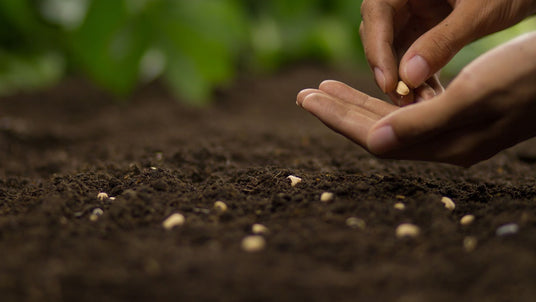

Sowing calendar: vegetable garden calendars per month for sowing, harvesting, storing and eating
 Pickers sowing calendar – Sow it yourself!
Pickers sowing calendar – Sow it yourself!

Bloemkool
Broccoli
Knolvenkel
Komkommer
Koolrabi
Pastinaak
Peterselie
Sperziebonen
Rode biet
Rode klaver (groenbemester)
Snijboon
Spinazie
Sowing calendars per month
View allWhy a vegetable garden calendar is more useful than a sowing calendar
On July 20, 2022, I had a whopping 12 cauliflowers . I left on July 21. When I returned 14 days later, I found 12 bolted cauliflowers in the depleted soil of my garden. Such a waste! And besides, I don't eat cauliflower in July; I want to enjoy the first juicy tomatoes. To avoid making this mistake again, I created these vegetable garden calendars by month (see above).
Having a vegetable garden is more than just planting seeds. Planning a vegetable garden isn't something you do overnight; it takes time. Think carefully about planning your garden and consciously use a sowing calendar. It's about consciously thinking and planning with the goal of sowing food. Showing off vegetables from your own garden is fun, but if your efforts don't reach your plate, it's all pointless.
Many people plan their vegetable gardens using a sowing calendar. For example, you sow cauliflower in March because the seed packet says it's okay. I've made the same mistake many times myself: sowing far too many vegetables at the wrong time. Use the sowing calendar to plan the right sowing time, so you know when to sow which vegetable. Sowing at the right time increases your chances of a successful harvest. A sowing calendar can help prevent soil fatigue by promoting crop rotation. Forget about when you can sow what, and start with the monthly calendars and click on harvest time. The harvest section for that month lists exactly which vegetables you can harvest from the garden that month, provided you sow or plant them at the right time. The crop to choose is indicated in parentheses.
The most frequently asked question about vegetable gardens is probably: "What can I sow now?" You'll find the answer below in our monthly vegetable garden calendars.
Plukkers' vegetable garden calendars are unique. Each calendar shows you what you can harvest each month, what you might have in your pantry, and what you can eat. The crops needed to harvest each month are also listed.
This way, you choose a crop that's tailored to what you want to eat and when, and you're not sowing just because you can. Clever idea, right?!
In four steps to the right vegetables with our vegetable garden calendars
Plukkers' vegetable garden calendars go beyond planting seeds and waiting for vegetables to appear. For the best quality and reliability, we recommend purchasing seeds from a trusted specialist.
How to proceed:
Step 1: Choose your vegetables and the month in which you want to eat them
Choose a vegetable you enjoy and decide when you want to eat it. In this example, I'll use Brussels sprouts. I like to eat Brussels sprouts from the moment the days get shorter until the beginning of spring. Let's say from October to early March, because you can probably enjoy your homegrown Brussels sprouts during this period.
Step 2: Check which crops are possible in the period you want to harvest and eat using the sowing calendar
Go to the October vegetable garden calendar and click on the harvest icon below to see which crop is listed next to Brussels sprouts.
That's right, you harvest Brussels sprouts in October through either the summer crop or the mid-early crop. So, Brussels sprouts can be harvested in October if you choose the right crop. The summer crop produces Brussels sprouts in October, and so does the mid-early crop. Now it's up to me to decide which crop to choose. Remember, I also enjoy eating Brussels sprouts in early March.
Step 3: Plant your crops at the right time using the sowing calendar or harvest calendar
Click on the green link in the harvest section of the October vegetable garden calendar. You'll see the crop sheet with all the crops and their growing periods.
The information on this page is very valuable. If you look at the four cultivation methods, you can already guess which crops are most interesting to me. I'll choose the Mid-Early (harvest October to December) and the Late (harvest November to the end of March). The summer crop will give me Brussels sprouts in August, and I'm not interested in that at all. So I'll sow my Brussels sprouts in March and April.
Step 4: How Many Plants to Grow for Your Family
Handing out loads of vegetables is wonderful; everyone appreciates a little something from the garden. But often we have limited garden space, and we grow them to provide our own food. A while ago, I wrote an article about " How much to sow and plant for my family ." At the link, you'll see, for example, that if four people in your family enjoy Brussels sprouts, six plants will be enough. Keep in mind that a Brussels sprout plant can easily take up 1 m² of space in your vegetable garden. So don't grow too many, unless you eat Brussels sprouts every day, in which case you'll need to adjust the quantities. But with three plants of mid-early and three plants of late, four people can eat all winter long.
vegetable garden calendar : in addition to the sowing calendar, there is also a storage calendar and a food calendar with delicious recipes
Besides sowing and harvesting, the monthly vegetable garden calendar also shows you what you can stock in your cupboard that month. Choose the right crop to achieve this. Click on the 'Stock' logo to do so.
For recipes using the crops from the harvest and storage calendar, you can scroll down to the bottom of the calendar or click on the "Eat" logo at the top of the monthly vegetable garden calendars.
For all vegetables
In this example I was talking about Brussels sprouts, but you can also use these vegetable garden calendars for lettuce , radish , endive , carrots or beans .
Thanks to the vegetable garden calendars, your vegetable garden is never empty.
Planning your vegetable garden according to these 4 steps might seem like a lot of work at first. But imagine how much time and space you'll save throughout the year if you have to care for just 6 instead of 20 Brussels sprouts. Let alone being able to drive around with your sprouts to hand them out. Think of how many novice or careless gardeners sow masses of vegetables without a single thing on their plate. With these vegetable garden calendars, you don't need 30 years of experience to get everything right at the right time. Planning next year's vegetable garden season now is an ideal winter chore.
Also read the article on 'crop rotation in the vegetable garden ', where you can apply some tips that will yield even better results. Are you a beginner vegetable gardener? Then be sure to read our article ' Creating a vegetable garden - this is the ultimate guide to getting started '. Good luck and a bountiful harvest!
Companion planting: smart combinations for a healthy vegetable garden
Companion planting is truly the way to get the most out of your vegetable garden. By cleverly combining different vegetables, herbs, and other plants, you can not only enjoy a much longer harvest but also give your crops a significant growth spurt and keep nasty diseases and pests at bay. It's all about choosing the right companion plants that complement each other and together create a thriving, healthy, and productive vegetable garden. Sowing under glass in a greenhouse can improve seed development and protect them from frost.
A nice classic example is planting beans and peas together with corn or zucchini. Beans and peas are real helpers – they absorb nitrogen from the air and fix it in the soil. This provides other vegetables, like corn and zucchini, with extra nutrients and helps them thrive. Onions and carrots also make a great duo: the spicy scent of onions keeps that pesky carrot fly at bay, while carrots help keep the onion fly away. By planting herbs like basil, chives, or dill among your vegetables, you attract beneficial creatures and keep the less attractive ones away. Handy, right?
When companion planting, pay close attention to the potting soil you use. Choose a nutrient-rich soil that retains plenty of water, so all your planted friends can grow optimally. Spring, especially – March, April, and May – is the time to get started sowing and planting. This is the time to fill your vegetable garden with a vibrant mix of vegetables and herbs, such as zucchini, beans, onions, and various types of lettuce. By planning now which crops you'll plant together, you can harvest abundantly and enjoy a bountiful harvest in July. It's important to monitor the germination temperature when sowing.
Are you short on space, for example, on a balcony or patio? No problem, you can also use companion planting there! Choose compact varieties and use vertical gardens or stackable pots. This way, even in a small space, you can grow a variety of vegetables and herbs and harvest them year-round. Pretty clever, right? Always read the instructions on your seed packaging and search online for tips on the best combinations and care.
Regular checks are important: observe your plants closely, watch how they're growing, and take immediate action if you spot any diseases or pests. This way, you'll prevent your harvest from being lost and keep your vegetable garden healthy. With a little planning, the right combinations, and attention to nutrition and care, you can enjoy fresh, healthy vegetables from your own garden all year round.
In short, companion planting is a smart way to get more enjoyment and results from your vegetable garden. By choosing the best companion plants, sowing and planting at the right time, and taking good care of your soil and plants, you'll create a vegetable garden that's not only a feast for the eyes but also packed with nutrients and yields a harvest. Start planning today and discover the difference companion planting can make!
If you find this information helpful, please share this article with your friends on Facebook. If you'd also like to support us, consider purchasing your garden supplies from our online store .
Tom











